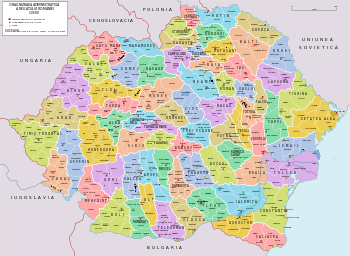Bălți County (Romania)
Bălți County was a county (Romanian: județ) in the Kingdom of Romania between 1925 and 1938, with the seat at Bălți.
Județul Bălți | |
|---|---|
County (Județ) | |
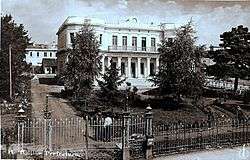 The Prefecture of Bălţi County building from the interwar period. | |
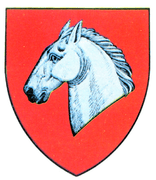 Coat of arms | |
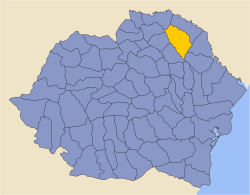 | |
| Country | |
| Historic region | Bessarabia |
| Capital city (Reședință de județ) | Bălți |
| Established | 1925 |
| Ceased to exist | Administrative and Constitutional Reform in 1938 |
| Area | |
| • Total | 4,246 km2 (1,639 sq mi) |
| Population (1930) | |
| • Total | 386,476 |
| • Density | 91/km2 (240/sq mi) |
| Time zone | UTC+2 (EET) |
| • Summer (DST) | UTC+3 (EEST) |
The county was located in the eastern part of Greater Romania, in the northern part of Bessarabia. Its territory now belongs to the Republic of Moldova, covering almost the territory of Moldova's Bălți County, which existed between 1998-2003.
The county neighboured the counties of Soroca to the east, Orhei to the south-east, Lăpușnaand Iași to the south-west, Botoșani to the north-east, and Hotin to the north.
Administration
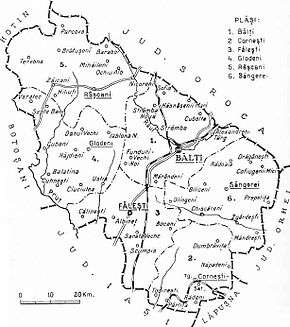
The county was originally administratively subdivided into three districts (plăṣi):[1]
- Plasa Fălești, headquartered at Fălești
- Plasa Râșcani, headquartered at Râșcani
- Plasa Slobozia, headquartered at Slobozia
Later, Bălți County was reorganized from the administrative point of view. The number of districts increased to six, by abolishing Plasa Slobozia and creating four new districts:
- Plasa Bălți, headquartered at Bălți
- Plasa Cornești, headquartered at Cornești
- Plasa Glodeni, headquartered at Glodeni
- Plasa Sângerei, headquartered at Sângerei
At the census of Autumn 1941, the county had the following administrative organization:
Population
According to the census data of 1930, the county's population was 386,721, of which 70.1% were ethnic Romanians, 12.0% Russians, 8.2% Jews, 7.6% Ukrainians, as well as other minorities.[2] From the religious point of view 89.3% of the population was Eastern Orthodox, 8.3% Jewish, 0.8% Roman Catholic, as well as other minorities.
Urban population
In the year 1930, the county's urban population was 30,570, of which 46.5% were ethnic Jews, 29.0% Romanians, 17.7% Russians, 3.2% Poles, as well as other minorities.[2] In the urban area the mother tongues were divided as follows: Yiddish (45.5%), followed by Romanian (28.1%), Russian (21.7%), Polish (2.0%), Ukrainian (1.1%), as well as other minorities. From a religious point of view, the urban population consisted of 47.1% Eastern Orthodox, 46.6% Jewish, 4.1% Roman Catholic, as well as other minorities.
Census data of 1941 - during World War II - indicate the county's population was 407,930, of which 80.44% were ethnic Romanians, 14.38% Ukrainians, 3.11% Russians, 0.78% Poles, 0.72% Jews, as well as other minorities.
After 1938
After the 1938 Administrative and Constitutional Reform, this county merged with the counties of Bacău, Baia, Botoșani, Iași, Neamț, Roman, Soroca and Vaslui to form Ținutul Prut.
The area county of the county was occupied by the Soviet Union in 1940 and became part of the Moldavian SSR. The area returned to Romanian administration following the Axis Powers' invasion of the Soviet Union in July 1941. A military administration was established and the region's Jewish population was either executed on the spot or deported to Transnistria, where further numbers were killed.[3] As the Soviet Union's offensive pushed the Axis powers back, the area again was under Soviet control. On September 12, 1944, Romania signed the Moscow Armistice with the Allies. The Armistice, as well as the subsequent peace treaty of 1947, confirmed the Soviet-Romanian border as it was on January 1, 1941.[4][5] The area of the county, along with the rest of the Moldavian SSR, became part of the independent country of Moldova.
References
- Portretul României Interbelice - Județul Bălți
- Recensământul general al populației României din 29 decemvrie 1930, Vol. II, pag. 48-49
- James Stuart Olson; Lee Brigance Pappas; Nicholas Charles Pappas (1994). An Ethnohistorical dictionary of the Russian and Soviet empires. Greenwood Publishing Group. p. 484. ISBN 9780313274978.
- "The Avalon Project : The Armistice Agreement with Rumania; September 12, 1944". avalon.law.yale.edu. Retrieved 17 March 2018.
- United States Department of State. Foreign relations of the United States, 1946. Paris Peace Conference: documents Volume IV (1946)
External links
| Wikimedia Commons has media related to Interwar Bălți County. |
- (in Romanian) Bălți County on memoria.ro
